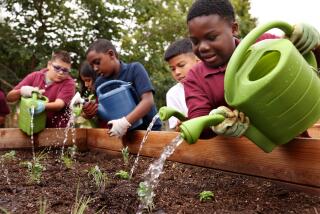Sowing Seeds of Knowledge
It took four months for 2nd Street School’s garden to blossom into a self-sustaining ecosystem on the blacktop playground. Once that happened, butterflies followed.
Students at the Boyle Heights elementary school planted passion vines and attracted gulf fritillaries. They put in basil and lured marine blues. Marigolds drew fiery skippers. Plantago has been a magnet for buckeyes.
The prize catch: a monarch that recently fluttered into the school’s parking lot, circled overhead and then glided low before alighting on a bunch of milkweed. With eyes fixed on the creature and its orange wings, one boy shouted, “Teacher, look! A kite!”
Los Angeles school district officials are so impressed with the teaching value of the garden that they hope to duplicate the effort at dozens of schools.
Kicking up Los Angeles’ urban butterfly populations is only one of the reasons teachers Brandon Scully and Irene Lavinia created the 60- by 40-foot garden.
By bringing back butterflies, 2nd Street students are applying mathematics, natural history and science lessons to the life cycles they investigate outside in low-tech planter boxes and flower beds.
Surveying a dozen students who were noisily hunting for insects in the garden with butterfly nets and collection jars, Scully smiled and said, “Here’s the payoff: In the 14 years I’ve been teaching here, I never heard a student say, ‘I want to be a scientist.’ Now, I hear it all the time.”
“We are dedicated to bringing back 32 urban butterflies to this school,” added Lavinia. “At the same time, our students are learning firsthand the value of saving living things. You can’t do that on computers alone. They can trust their senses here. This is real.”
Their mentor is Rudi Mattoni, a nationally recognized butterfly expert who teaches biogeography at UCLA. Mattoni was instrumental in providing the school with horticultural advice and the seeds needed to woo the butterflies and other insects.
During his first tour of the 2nd Street School garden last week, Mattoni said, “Most schools don’t understand the opportunity that exists in gardens like this one. . . .
“Yet, butterflies are the best damn teaching tools I can think of,” he said. “To produce butterflies, students must learn to grow plants, then propagation techniques, seed and nutrient cycles. When the butterflies come--and they will come--students can identify and collect them, or dot their wings with felt pens and recapture them later to determine migration routes and population patterns.”
Even as he spoke, students were noting the wind speed on an anemometer nailed to a post, snipping seed pods with scissors, gathering feathers left by marauding crows and sparrows, and measuring leaves for signs of growth. In a nearby classroom, still others were preparing to weigh seeds collected in the garden on scales that were confiscated in drug raids and donated by the Los Angeles Police Department.
“I helped plant the seeds that made this passion vine,” said 7-year-old Martha Hernandez, proudly stretching a measuring tape from the ground up to the top of the 2-foot vine curled around a ladder of plastic pipe. “Hmmm. It’s taller than it was a few weeks ago. And look at that! It has caterpillars on it.”
“Look what I caught!” interrupted a boy holding up a butterfly net containing a nervous insect with brownish-red wings.
“Nice catch,” Mattoni said, nodding his head with approval. “It’s a funereal duskywing, which is not a garden variety of butterfly and unusual for these parts. But we can’t know what these gardens will eventually produce because there aren’t enough of them out there.”
At least not yet. On Oct. 27, Mattoni is expected to conduct a seminar for 80 teachers, parents and administrators from 25 Los Angeles school district campuses wanting to create habitats that will invite native butterflies.
Mattoni is offering free seeds to start more of the gardens, which have won strong support from educators including Janet Thornber, director of programs for science teachers at UCLA.
*
“Inner city children sometimes feel they are powerless to do something about conserving habitats without the help of expensive special equipment or specialists,” she said. “In fact, they have a role to play--and the power--to improve the world environment and make this a great city.
“But before they can relate to the damage being done to the world’s ecological systems, they must learn that we have endangered species on our doorstep,” she said. “Urban butterfly gardens can help them to do that.”
Scully is aiming for even more than that with the garden she started in 1990 with a wine crate, a few shovelfuls of dirt and a few marigold seeds.
“When our kids grow up,” she said, “they’ll say, ‘Wow! My school had a huge garden.’ Only it will be even bigger in their memories.”
“They’ll never forget the shock of watching spiders attack butterflies on big yellow flowers, or of pulling up roots and finding grub worms, or of aphids shedding under the lens of a microscope,” she said. “They won’t forget how neighbors gathered here on Mother’s Day to have their pictures taken, and how parents told their sons and daughters, ‘I’ll meet you in the garden after school.’ ”
And they won’t forget, she said, the sciences classes that began with an unusual order in the overgrown plantation: “Kids, let’s all take a deep breath and smell the earth.”
“The distinctive odor of good dirt will forever trigger memories of childhood and school and learning, and how each spring we were in butterfly heaven,” she said. “They will remember how this garden was not only enjoyable, it also was valuable.”







